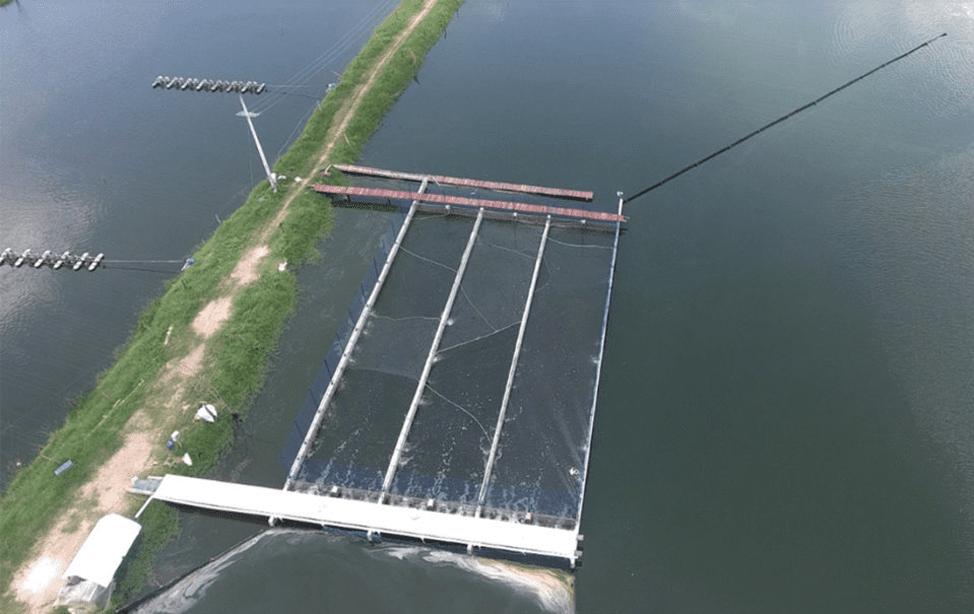IPRS Technology Boosts Growth, Survival, and Economic Performance at Colombian Tilapia Farm
- Category:
- Aquaculture
- General News

USSEC has been working with El Guajaro Aquaculture, a commercial tilapia farm near Cartagena, Colombia, which faced a challenging situation regarding its water supply. The farm can no longer pump water from El Guajaro Lake due to its highly eutrophic water. The lake’s water quality, however, is suitable for aquaculture, with alkalinity averaging 401 meq/L (milliequivalents per liter; range 380 to 420), hardness averaging 161.5 mg/L, (145 to 185); pH averaging 8.12 (7.9 to 8.4), and salinity values between 0.6 to 1.0 ppt. Therefore, the farm recently set up a water recirculating system that does not use water from the lake. The original farm water has a heavy organic load, which affects dissolved oxygen on the farm.
The Global Aquaculture Alliance recently carried out a study to assess the performance of vaccinated Nile tilapia in an in-pond raceway system (IPRS) at El Guajaro Aquaculture. USSEC provided financial support for this trial.
The farm designed a 1.14-hectare pond with an average depth of 1.4 meters and a total volume of 15,960 cubic meters. Three IPRS raceways were built in the pond, each with 154 cubic meters of culture volume, for a total raceway culture volume of 462 cubic meters and representing 2.89 percent of the total pond water volume.
Each raceway was stocked with 25,044 tilapia fingerlings (average weight 41.3 grams) vaccinated against the bacterium Streptococcus agalactiae type B. Fish were stocked at 163 fish per cubic meter and an initial biomass of 6.72 kg per cubic meter. Fish growth was assessed biweekly, and various water quality parameters were monitored twice a week, including dissolved oxygen, temperature (twice daily, morning and late afternoon) ammonia, nitrite, pH, hardness and alkalinity. Fish were fed six times a day the first month and then fed no less than four times a day (based on body weight) rest of the trial. Mortalities were collected from the raceways and counted.
Fish were fed a USSEC formula feed with 38 percent crude protein (CP) on the first month and 32 percent CP for the rest of the study. This diet also included 6 percent lipids, 12 percent humidity, 10 percent fiber, 12 percent ash and 48 percent soy inclusion.
When the fish reached 100 to 125 grams, the small screens of the IPRS were removed and replaced with larger screen mesh. Use of larger screens and screen maintenance improved water flow through the raceways as the fish grew and required better water quality.
The vaccinated tilapia used in this trial yielded a total of 25,327 kg per ha, with a survival of 83 percent, an FCR averaging 1.29 and an average weight gain of 4.34 grams per day. El Guajaro Aquaculture typically has survival rates of 60 percent using non-vaccinated tilapia. Although non-vaccinated raceways were not included in this study, the Streptococcus agalactiae type B, vaccination appeared to have increased survival rates of 83 to 85 percent. Endemic low dissolved oxygen across the farm contributes to fish stress and traditional pond production as low as 15,000 kg per ha per harvest.
Use of IPRS technology increased production vs. traditional pond results, from 15 tons per ha to 25 tons per ha per harvest. One important aspect of the IPRS is that frequent removal of fish waste in the system likely had a significant positive impact in increasing tilapia production. The farm’s 16 percent return on investment (ROI) for traditional ponds was increased to 30 percent in the IPRS system, an increase of 53 percent.

To read the complete story from the Global Aquaculture Alliance, please click here.